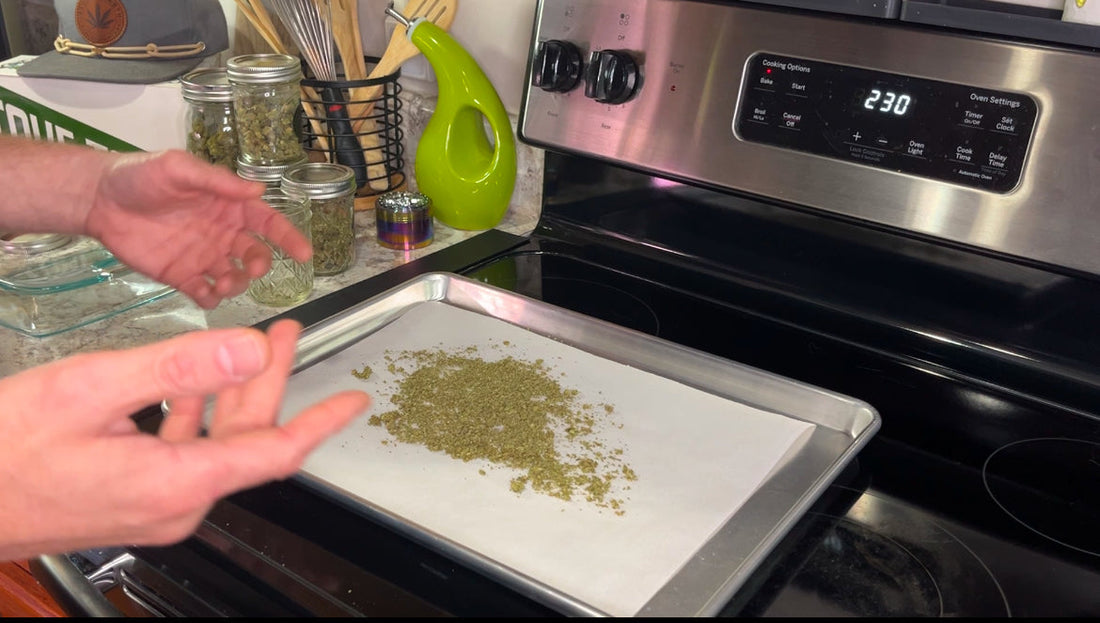
Why and How to Decarb Your Flower - Start Cooking with Cannabis
Why and How to Decarb Your Flower
Why do we have to?
Simply put - eating raw weed will not get you high. You’d still be ingesting lots of compounds with very beneficial effects, but the psychoactive component wouldn’t be there. The decarbing process is essential to experiencing the euphoric properties of THC. The simplest way to decarb your weed is to light it on fire and inhale the smoke. But if you’re reading this, you likely want to make some delicious food and well, you can’t cook with ashes. So let’s discuss other options.
THCA vs THC
Raw herb won’t get you high because in its raw form, it contains THCA (delta-9-tetrahydrocannabinolic acid) which cannot bind to the cannabinoid receptors in our brains. By decarboxylating our weed, we are removing the carboxyl group acid by turning it into carbon dioxide and leaving the THC (delta-9-tetrahydrocannabinol) cannabinoid that can bind to the receptors in our brains.
The methods of cannabis decarboxylation usually involve one of the following: acid, solvent, cold water, friction/compression, or heat. What we do at home almost always involves heat.
Well, if we take raw flower and mix it with our brownie mix and toss it in the oven, wouldn’t the heat in there decarb the zaza?
Yeah, kinda, not really. We need to heat the cannabis enough to break down the carboxyl group acid in the THCA but not high enough to burn the THC cannabinoid itself… we only want to burn the A off. Luckily for us, the scientists have already published all the research and we know what temperature range and timeframe is required for THCA decarboxylation. We also know the boiling points of the different cannabinoids (THC isn’t the only one, my CBD lovers) and where the terpenes start to degrade before combustion.
We need a specific temperature range for a specific amount of time, and no, it’s not the same as a box of instant brownies.
A Few Methods
Oven Baking
A simple, time-tested technique that requires nothing beyond what you likely already have in your kitchen: a pan, parchment paper, oven mitts, and an oven. If you are offended by the smell of cannabis or need to be discrete due to your particular living arrangements, you may wish to choose another technique.
- Preheat your oven to 230 degree F
- Loosely grind your weed or break it apart with your fingers. You don’t want it too fine or it may overcook, lowering its THC concentration in your infusion. We’re looking for rice-grain size.
- Cover a baking pan or glass casserole dish with parchment paper
- Spread the cannabis in an even layer on the parchment paper
- Bake for 20 mins then check the flower. Give it a good shake. It should be slightly brown but not burnt and will be very aromatic. Don’t overbake the bud!
Smaller amounts of flower (less then 14g) or dry flower can be fully decarbed in about 30 minutes. That sticky-icky, moist, green bud or larger amounts (over 28g) can take upwards of 60 mins. The reality is your exact bake time will depend on the quantity and moisture content of your cannabis. Just keep an eye on it and keep shaking it every 15-20 mins until its uniformly browned,
Mason Jar
If you’re only decarbing a small amount of flower (3.5 - 7g), you can oven bake it in a mason jar to reduce the aroma. Use the same basic method above, however put the cannabis in a closed mason jar, put a folded, damp towel on the baking sheet, and put the mason jar on its side on the wet towel.
Sous Vide
The sous vide technique leverages a slow-cooking technique that involves completely immersing your vacuum-sealed cannabis in a hot water bath. Because of this, the pleasant cannabis aroma isn’t filling your living space while it decarbs. Additionally, the sous vide method is very precise - you don’t have to worry much about overbaking and losing potency.
- Finely grind your cannabis and vacuum seal it in a plastic bag
- Fill a large stockpot (or whatever vessel you use with your sous vide) with hot water
- Place your bag o’ weed in the water
- Set your sous vide circulator to 200 degrees and immerse it in the water
- Let the magic happen for about 2 hours. When complete, the bud should be a golden tan color.
Vaporizing/AVB
The easiest method if you already vape bud.
You want to take in THC when you vape, so the oven chamber of your vape has to exceed the boiling point of THC molecules. This method is more of a useful secondary way to get high on the same supply again as the vape chamber boils off 65-75% of the THC cannabinoids in the flower. The toasty bud leftover in the vape chamber is known as AVB - Already Vaped Bud. It’s already been heated beyond the decarb temperature so it’s ready to move onto the infusion step of your recipe. Just remember that because it burns off up to 75% of the THC cannabinoids, you’ll need about 4x the weight of the decarbed bud called for in an infusion. For example, an infusion recipe that calls for 3.5g of decarbed bud would need 14g of AVB, roughly.

